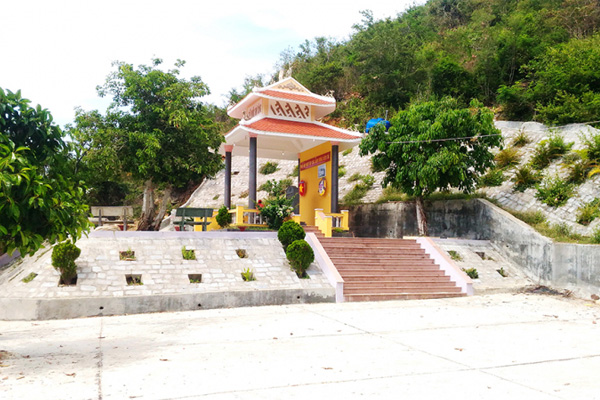Description
The historical site of the Hon Heo revolutionary base is in Tien Du village, Ninh Phu commune, Ninh Hoa town.
Hon Heo revolutionary base is a mountain range located in the east of Ninh Hoa district (now Ninh Hoa town), about 45 km from Nha Trang city, three sides protruding to the sea. The whole area of Hon Heo is about 200 square kilometers. The North has Hon Khoi estuary bordering Van Phong Bay. The West is a fertile plain, the South has Nha Phu Lagoon with many small islands such as: Hon Coc, Hon Ro, Hon Cu Lao... the largest is Hon Thi. To the east is the sea with islands: Hon Bac, Hon Cha La, Hon Dun... Hon Heo peninsula is created by Phuoc Ha Son mountain range including many high peaks such as: Top of Mai Nha 725m, Mount Tien Du 777m, Mount Hon Hon. Heo 778m, Hon Noc Rom 813m... there are many streams flowing to the villages along Hon Heo such as Mo Cay stream (Ninh Tinh), Cay Sung stream (Dam Van), Tien Du stream, Hoa Lan stream (Ninh Phu). Hon Heo has many streams and caves, which are naturally mixed with dense forest trees. Around Hon Heo is a rich residential area including many communes and wards: Ninh Da, Ninh Phu, Ninh Phuoc, Ninh Van...

(A view of the historical site of the Hon Heo revolutionary base site - Photo: Nguyen Chi Khai)
With favorable natural and social conditions, Hon Heo area became the revolutionary base of the district (now Ninh Hoa town) and Khanh Hoa province during the two resistance wars against the French colonialists and imperialists. America invaded.
The August Revolution in 1945 succeeded, the country gained independence. By the end of August 1945, the revolutionary government apparatus in Khanh Hoa from province to district and commune was established. However, the fledgling government apparatus was still unstable. In September 1945, the French army returned to invade our country; They landed on Nha Trang beach to capture some important positions and then expanded to the whole province.
In that context, a big problem for the Khanh Hoa Provincial Party Committee at this time is to build a solid and long-term base for the provincial and district leadership agencies to direct the resistance war. At the beginning of the resistance war, the Provincial Party Committee and the provincial government consciously prepared the rear. Recognizing the problem early, after the Nha Trang Front was broken and the French colonialists betrayed the Preliminary Agreement on March 6, the provincial agencies moved to Hon Du (Dien Khanh). The interim Ninh Hoa Party Committee, the Viet Minh Front, the Administrative Resistance Committee (UBKCHC) and the mass organizations moved to Hon Heo, taking this as a base to prepare for a long-term resistance war.
By the end of 1948, to be suitable with the actual situation, the Provincial Party Committee moved its agency to Hon Heo because it was strategically located as a transit point between land and sea communication routes between districts in the province and Phu Yen free zone, Binh Dinh. Thus, from the end of 1948, Hon Heo was also the base of Khanh Hoa Province and Ninh Hoa district.
Located between the mountains of Hon Heo revolutionary base is Hon Ngang site with an altitude of about 400m, about 500 hectares wide, in front of Hon Ngang valley. East of Hon Ngang is Chilli slope, the point connecting the East and West of Hon Heo base, from Hon Ngang through Chit slope down to Ninh Phuoc, Ninh Van from here can enter Nha Trang or go to Area V.
Hon Ngang was chosen as the center of Hon Heo revolutionary base, a place to commemorate many historical events of typical value. In particular, this place with its favorable location and natural terrain, the Provincial Party Committee chose to hold the first Khanh Hoa Provincial Party Congress in March 1950. The congress took place in the historical context, the Khanh Hoa resistance movement after the autumn-winter campaign is declining and facing difficulties. Our military force is still weak "not enough to have a strong impact on the political establishment and actively hold out against the enemy", especially after the Truong Chinh campaign took place in Nam Khanh, the movement situation has deteriorated. Therefore, the first Party Congress of Khanh Hoa province was held with an important meaning, on the basis of a thorough assessment of the battlefield situation in the country and in the province with the slogan "Preparing for a strong transition to the military. counterattack”. The Provincial Party Committee has clearly pointed out the advantages, disadvantages and limitations that need to be overcome, thereby orienting the entire Party and people to continue improving the Party's leadership capacity, the fighting strength of the entire people, and promoting the spirit of the union. of the entire nation. The Congress elected 13 outstanding comrades to the Executive Committee to lead and direct the Khanh Hoa army and people to repel the invading French colonialists, contributing to the overall victory of the country.
Today, Hon Ngang is a wild mountainous area with dense trees, the landscape of the relic site is still the same as before, without any major human impact. However, traces of camps, halls, production fields as well as artifacts related to the first Khanh Hoa Provincial Party Congress are no longer present due to the influence of time and the development of the province. Forest tree. In the past, this was the field and garden of the self-sufficient production facility to provide food and food for the base, now partly a dense forest, partly a concrete road and Tien Du lake bed.
With typical historical value, the relic has been ranked as a provincial historical - cultural relic by the People's Committee of Khanh Hoa province issued Decision No. 283/QD-CT.UBND, dated February 3, 2021 .
NGUYỄN CHÍ KHẢI